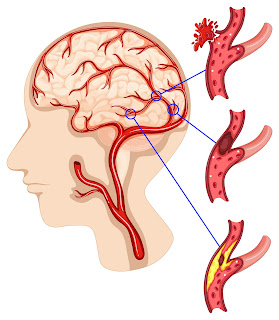A stroke can happen when blood flow to a part of the brain is blocked or reduced, depriving the brain of oxygen. It can cause permanent damage, leaving lasting impacts on one’s health. However, the good news is that many strokes can be prevented by making simple yet effective lifestyle changes, particularly with a focus on maintaining a healthy heart.
In this article, we'll explore actionable tips for preventing stroke and ensuring your heart stays in top shape.
1. Maintain a Healthy Diet
Eating a balanced diet rich in fruits, vegetables, whole grains, lean proteins, and healthy fats is crucial for heart health. Avoiding processed foods, excess salt, and sugary snacks can help maintain healthy blood pressure and cholesterol levels, both of which are key factors in reducing stroke risk. Incorporate foods like leafy greens, berries, and fatty fish (such as salmon) that are rich in antioxidants and omega-3 fatty acids.
Tip: Try to limit saturated fats, trans fats, and sodium to help lower cholesterol and maintain healthy arteries.
2. Exercise Regularly
Regular physical activity can improve blood circulation, reduce inflammation, lower blood pressure, and strengthen your heart muscle. Aim for at least 150 minutes of moderate-intensity aerobic exercise (like brisk walking or cycling) each week. Along with cardiovascular workouts, incorporate strength training and flexibility exercises to maintain overall fitness.
Tip: Start with small goals like walking 20-30 minutes a day and gradually increase your activity levels.
3. Control Blood Pressure
High blood pressure (hypertension) is one of the most significant risk factors for stroke. It puts extra pressure on your blood vessels, which can lead to their weakening and eventual rupture. Monitoring and controlling your blood pressure through lifestyle changes, stress management, and, if necessary, medication is essential for stroke prevention.
Tip: Keep your blood pressure below 120/80 mm Hg to reduce your stroke risk.
4. Quit Smoking
Smoking is a major contributor to cardiovascular disease and stroke. It damages blood vessels, reduces oxygen in the blood, and promotes clotting. Quitting smoking is one of the most impactful steps you can take for your heart and overall health. If you're struggling with quitting, seek support through counseling or smoking cessation programs.
Tip: Find a support system or try nicotine replacement therapies to increase your chances of quitting successfully.
5. Limit Alcohol Consumption
Excessive alcohol consumption can lead to high blood pressure, irregular heart rhythms, and an increased risk of stroke. It's recommended to limit alcohol intake to moderate levels — that’s one drink per day for women and up to two drinks per day for men.
Tip: Aim to drink in moderation and avoid binge drinking, which can lead to severe spikes in blood pressure.
6. Manage Stress Effectively
Chronic stress can raise blood pressure and increase inflammation, both of which contribute to heart disease and stroke risk. Finding healthy ways to cope with stress, such as through mindfulness practices, deep breathing, yoga, or other relaxation techniques, can help manage its impact on your health.
Tip: Dedicate time to relaxation each day to help reduce your overall stress levels.
7. Control Your Cholesterol Levels
Having high levels of LDL (bad) cholesterol can lead to plaque buildup in your arteries, increasing the likelihood of stroke. Regularly checking your cholesterol levels and working with your healthcare provider to manage them is an important step in stroke prevention.
Tip: Include heart-healthy foods like nuts, oats, and avocado in your diet, and aim to keep your total cholesterol levels in check.
8. Get Regular Health Screenings
Routine check-ups and screenings are important to detect any risk factors for stroke early on. Regular monitoring of your blood pressure, cholesterol, blood sugar levels, and overall heart health can help catch issues before they become serious.
Tip: Schedule an annual physical exam with your doctor to assess your stroke risk factors.
Top FAQs About Stroke Prevention
1. How can I reduce my risk of having a stroke? To reduce your stroke risk, adopt a heart-healthy lifestyle. Maintain a balanced diet, exercise regularly, manage blood pressure and cholesterol, quit smoking, limit alcohol intake, and manage stress.
2. Is it too late to start preventing stroke if I’m older? It’s never too late to make changes that improve your health. Even in older age, making lifestyle adjustments such as eating a healthier diet, staying active, and quitting smoking can significantly reduce your stroke risk.
3. Can drinking water help prevent a stroke? Staying hydrated is important for overall health, including heart health. While water alone won’t prevent a stroke, drinking enough water ensures that your blood flows more easily, which supports proper circulation.
4. How does stress contribute to stroke risk? Chronic stress can raise your blood pressure and contribute to inflammation, both of which are significant risk factors for stroke. Managing stress through relaxation techniques can help reduce your risk.
5. How often should I get my cholesterol and blood pressure checked? It's recommended to check your cholesterol and blood pressure at least once a year, especially if you're over 40 or have a family history of heart disease or stroke. Regular monitoring helps catch any abnormalities early.
Final Thoughts
Stroke prevention is largely within your control, and by adopting a healthy lifestyle, you can significantly lower your risk. From eating a nutritious diet to staying active, managing stress, and checking your health regularly, each small step you take towards improving heart health adds up to a big difference in stroke prevention.
By focusing on habits that support a healthy heart, you’re not only reducing your risk of stroke but also improving your overall well-being. Start today, and make healthy choices to protect your heart and brain for a brighter, healthier future.


%20Foods%20That%20May%20Ease%20Your%20Pain.jpg)



%20Benefits,%20Nutrition,%20Side%20Effects,%20and%20How%20to%20Use.jpg)





No comments:
Post a Comment